I took these pictures in St. Paul, Minnesota, on the morning of September 8, 2002, while traveling on Amtrak’s eastbound Empire Builder. St. Paul was a highlight for me, as the Minnesota Commercial and Soo Line equipment visible from the train seemed exotic to an Oregonian like me.
Switching at Amtrak’s Midway Station in St. Paul during the Empire Builder’s service stop, Minnesota Commercial #316 is a 2,400-horsepower RS-27 that was built by Alco Products in March 1962 as Chicago & North Western Railway #903. Only 27 examples of the RS-27 were produced; the Chicago & North Western owned four, which were returned to Alco in 1966 in trade for C-424s. Alco leased them to various railroads in 1967 and 1968. This unit was sold to the Green Bay & Western in 1968 and became #316. It was later joined by two of the others. On August 27, 1993, the Green Bay & Western was merged with the Fox River Valley Railroad to form the Fox River & Western, a subsidiary of the Wisconsin Central, and this locomotive was sold to the Minnesota Commercial Railroad.
Parked on a track at Midway Station were three privately-owned passenger cars, the Caritas, the Sierra Hotel, and the Puget Sound.
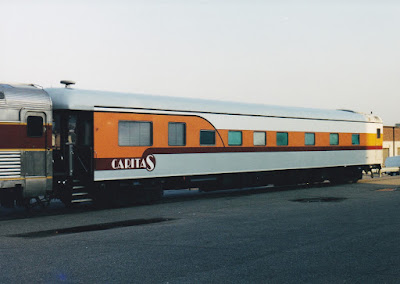
The Caritas was built in 1948 by Pullman as a 4-Bedroom, 14-Roomette Sleeping Car for the St. Louis-San Francisco Railway, or Frisco for short. The car was originally named Pierre Laclede after the founder of St. Louis. The car was originally assigned to the Texas Special, which ran between St. Louis, Missouri, and San Antonio, Texas, over the Frisco and the Missouri-Kansas-Texas. The Frisco discontinued its portion of the Texas Special (the northern portion) in 1959. In 1964, this car was sold to the Canadian National and named Churchill Falls. High Iron Travel bought the car in 1983 and rebuilt it to its current configuration, with 3 double bedrooms and a master room, dining area, galley, wine cellar, and lounge. I had seen the Caritas here before in 1999 wearing a red and white paint scheme; it had since been repainted in the same pattern but using Milwaukee Road colors, as shown here.
Sierra Hotel was built by the Budd Company in October 1948 as Chicago, Burlington & Quincy #251 Silver Lounge for use on the California Zephyr between Chicago and Oakland. This mid-train Dome-Dormitory-Buffet-Lounge car originally included dormitory space for 15 crew members, a lounge under the dome that was remodeled into the “Cable Car Lounge” in 1964, and a buffet with seating for 19 passengers. After the Chicago, Burlington & Quincy was merged into the Burlington Northern on March 2, 1970, it became Burlington Northern #251. The California Zephyr made its last run on March 24, 1970, and when Amtrak took over passenger service on May 1, 1971 it was sold to become Amtrak #9811. It was used on Amtrak trains including the North Coast Hiawatha and the Texas Chief before being retired in October 1981 and being sold into charter service as Vandalia Railroad #9811. In 1989 the car was rebuilt by Midwest Railcar as open-end observation car Sierra Hotel. The open observation deck was built into what was originally the front of the car, so it now typically operates in the opposite direction of what was intended when it was built.
Puget Sound was built by the Budd Company in June 1955 as Great Northern #1323 for use on the Empire Builder between Chicago and Seattle. It was originally built as a Great Dome coach with 46 revenue leg-rest seats plus seating for 24 people in the dome. After the Great Northern was merged into the Burlington Northern on March 2, 1970, it was assigned Burlington Northern #4603, but it did not receive this number before Amtrak took over passenger service on May 1, 1971 and it was sold to become Amtrak #9463. It was retired in 1985 and sold into private ownership and stored in Fargo, North Dakota, and Sault Ste Marie, Wisconsin, until being converted into sleeping car Puget Sound by Avalon Railcar in Milwaukee, Wisconsin, in 2000. As part of the rebuilding, its original smooth side panels were replaced with fluted panels to match Sierra Hotel.
Amtrak’s Empire Builder passes Minnesota Commercial’s nearby roundhouse in Minneapolis. Minnesota Commercial #1978 is a 2,250-horsepower B23-7 that was built by General Electric in April 1979 as Conrail #1978. It was retired in 1999 and sold to the Minnesota Commercial Railway, where it retained its original number.
Conrail #2002 is a 2,250-horsepower B23-7 that was built by General Electric in August 1979. It was retired by Conrail in 1999 and was sold to the Minnesota Commercial Railroad, but has yet to be placed in service and still wears full Conrail paint and lettering.
Minnesota Commercial #1B is a 1,600-horsepower RS3 that was built by the American Locomotive Company in September 1950 as Lake Superior & Ishpeming #1504 and was soon renumbered to #1604. It was retired in September 1989 and was sold to Clint Jones. It was sold to the Minnesota Commercial Railway in 1998 and was rebuilt as 1B in 1999.
Soo Line #4002 is a Fuel Tender that was originally built by the Electro-Motive Division of General Motors in February 1958 as Milwaukee Road #2371, a 1,750-horsepower GP9. Milwaukee Road renumbered it to #263 before rebuilding it into “GP20” #949 in the 1970s. The Soo Line purchased the bankrupt Milwaukee Road in February 1985. The locomotive was rebuilt into Fuel Tender #4002 in November 1987. Coupled to it is a CP Rail 40-foot boxcar, which was rare to see in the 21st century. It is painted in the “Multimark” paint scheme, which was applied from 1968 to about 1987.
Soo Line Flatcar #954541 is a flatcar with an Operation Lifesaver display of crossing signals and an automobile involved in a grade crossing accident. Also pictured here are former Soo Line #1400 & #1401, 1,500-horsepower SW1500s that were built by the Electro-Motive Division of General Motors in November 1966 as Minneapolis, Northfield & Southern #36 & #37. The Minneapolis, Northfield & Southern was merged into the Soo Line on January 1, 1986. These were the only SW1500s on the Soo Line. They had been recently retired with their road numbers stricken out. Also pictured here is a Soo Line extended vision caboose. The road number is unclear but appears to be either #60 or #80. In either case, it was built by the International Car Company in 1973.
Soo Line MP15AC #1548 is a 1500-horsepower MP15AC that was built by the Electro-Motive Division of General Motors in September 1975 as Milwaukee Road #482. The Soo Line purchased the bankrupt Milwaukee Road in February 1985, and this locomotive became Soo Line #1548. It was never repainted into Soo Line colors and remains in its Milwaukee Road paint with its former road name and number painted out with black paint. Patched former Milwaukee Road locomotives on the Soo Line were known as “bandits.” In the background is one of four former North Louisiana & Gulf MP15DCs #42-45, built by the Electro-Motive Division of General Motors in November 1975, that has been acquired by CP Rail in 1996 and became CP Rail #1434-1437. The North Louisiana & Gulf was purchased by the MidSouth Rail Corporation on September 8, 1987, which operated it as the MidLouisiana Rail Corporation. On January 11, 1994, MidSouth was taken over by Kansas City Southern. Also (barely) visible is a Soo Line extended vision caboose in the later brown paint scheme.
Soo Line MP15AC #1538 is another 1500-horsepower MP15AC that was built by the Electro-Motive Division of General Motors in September 1975 as Milwaukee Road #472. This MP15 was paired with CP Rail #776, a 3,000-horsepower SD40-2 built by the Electro-Motive Division of General Motors in October 1974 as Soo Line #776, for hump yard service at Pig’s Eye Yard in St. Paul. The Soo Line was consolidated into owner CP Rail in 1991, and in March 1993 SD40-2 #776 received the new CP Rail System paint scheme combining the American and Canadian flags, symbolizing CP Rail’s operations in both the United States and Canada.

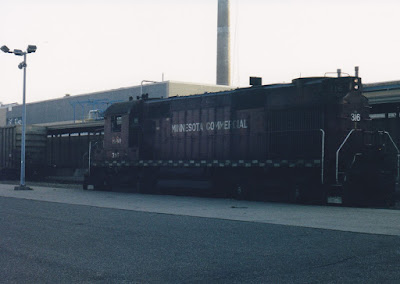





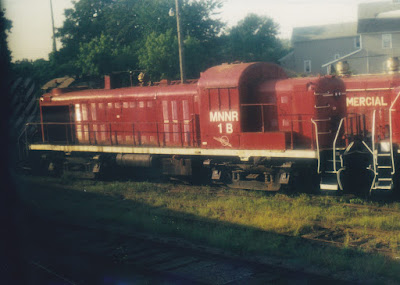
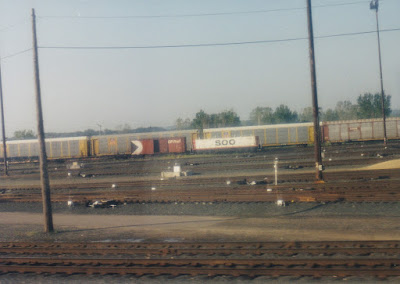

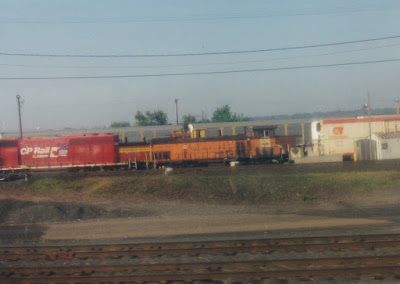
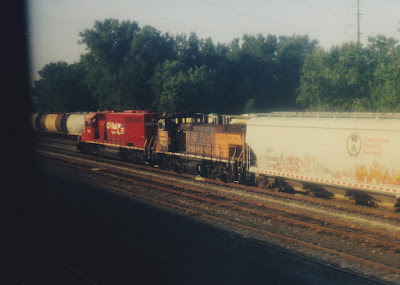
No comments:
Post a Comment